“I have a British background and I have always had tea and something sweet. First time I tried this clotted cream I almost ate the entire jar by itself, it is that good!” ~Kim

If you’ve never had a classic English afternoon tea with scones and clotted cream, you’re missing out!
Last week I was treated by the historic Biltmore Hotel in downtown Los Angeles to their classic English afternoon tea. If you’ve never had a classic afternoon tea, you need to experience it. The highlight of any afternoon tea, besides the tea, is the array of tiny treats that comes with it, and I always zero right in on the scones and clotted cream. (That’s them on level two of our 3 tiered tea tray.)

What is Clotted cream?
If you’ve never had it, clotted cream is a very thick rich spreadable form of heavy cream that was first invented ages ago by some very smart British farmers. Traditionally cream heated until it thickens and develops a slightly nutty flavor. Clotted cream has a high fat content (around 55-65%) and a dense texture. It’s not like whipped cream, or cream cheese, it’s not like butter…it has a unique decadent consistency and a wonderful soft flavor. It’s quite thick and spreadable, and when you slather it on a freshly baked scone there is no better thing in the world.
The little pot of clotted cream that we got at the Biltmore had me craving more, and happily I made the most astounding discovery…you can actually make clotted cream at home in your own kitchen. No more tracking it down in specialty stores and paying big bucks for the imported stuff. My homemade clotted cream was actually way better (and a whole lot fresher) than the British stuff I usually buy.

What does clotted cream taste like?
Clotted cream has a rich, creamy taste with a slightly nutty ‘cooked’ flavor. It’s luxurious and indulgent, with a dense, velvety texture that is thicker and creamier than regular whipped cream. Clotted cream is also slightly sweet, but not as sweet as whipped cream or frosting, with a delicate flavor that pairs well with desserts, fruit, and scones. The crust on top of the clotted cream adds a slightly caramelized and nutty flavor, which many people find particularly delicious. The mouthfeel of clotted cream is a key part of its charm, and is like nothing else you’ve ever had!
what you’ll need
- heavy or whipping cream that has not been ultra-pasteurized
- This is cream that has been pasteurized, but not ultra-pasteurized. Ultra-pasteurized cream is cream that has been heated to a higher temperature than regular pasteurized cream to extend its shelf life.

How to make clotted cream
This is an amazing process, I hardly had to do anything, and I end up with a ton of the richest, silkiest clotted cream I’ve ever had.
- I used 2 pints of (non-ultra-pasteurized) heavy cream.
- I poured them into a baking dish, and left it overnight in a 180F oven (the lowest my oven will go.)
- In the morning I let it cool and then refrigerated it for the rest of the day.
- Then I scooped it into jars, which was a little sloppy at first, and put them back in the refrigerator. Any little bit of liquid gets absorbed right into the clotted cream after you put it in the jars, and by the next morning when I had it with my scones, it was absolutely to die for.
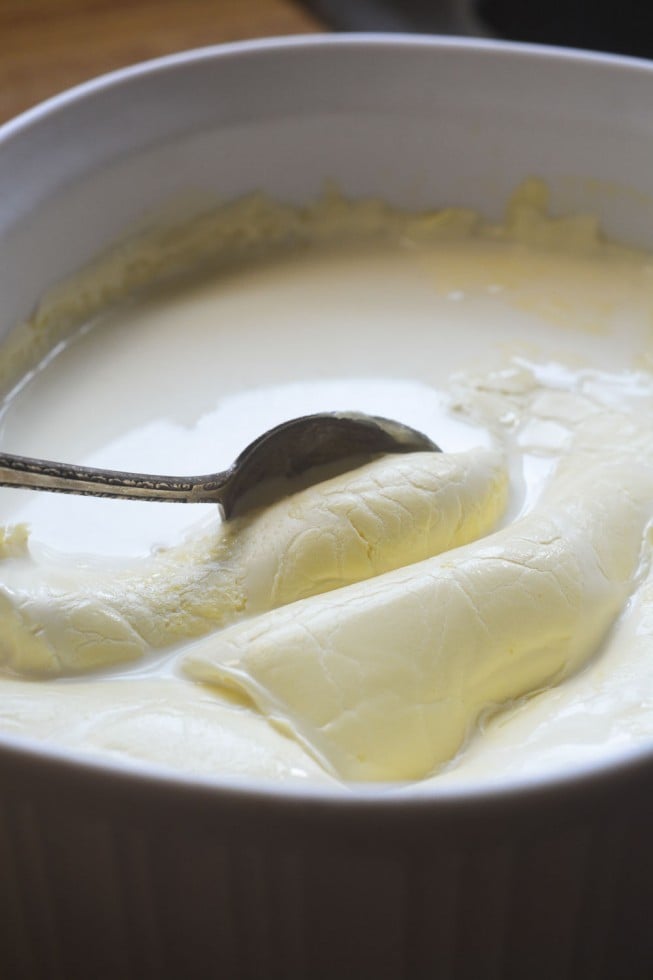
How long does clotted cream last?
Homemade clotted cream can last for up to 3-4 days when stored properly in the refrigerator. To extend its shelf life, it’s important to keep it in an airtight container and store it in the coldest part of the refrigerator, such as the back of the bottom shelf.
It’s important to note that clotted cream does not have any preservatives, so it should be consumed as soon as possible for the best flavor and texture. If you notice any changes in color, texture, or odor, discard the clotted cream immediately as it may have spoiled.
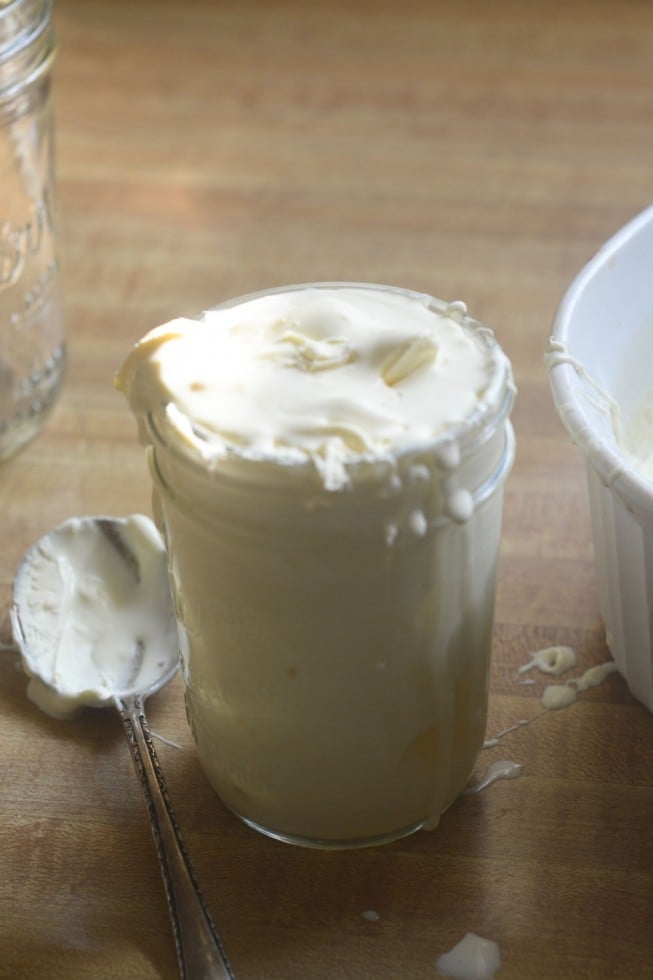
What to do with the leftover whey from making clotted cream
The leftover whey from making clotted cream can be used in a variety of ways:
- Adding it to smoothies or protein shakes for a boost of protein and nutrients.
- Using it as a substitute for milk or water in baking recipes such as bread, muffins, and pancakes.
- Using it as a marinade for meat or fish to tenderize and add flavor.
- Adding it to soups or stews for added richness and flavor.
- Using it as a liquid base for making homemade ricotta cheese or other soft cheeses.
- Feeding it to pets, as it is a good source of protein and nutrients for animals.
Note: It’s important to keep in mind that the leftover whey should be used or stored promptly to avoid spoilage. It can be stored in the refrigerator for up to a week or frozen for longer storage.
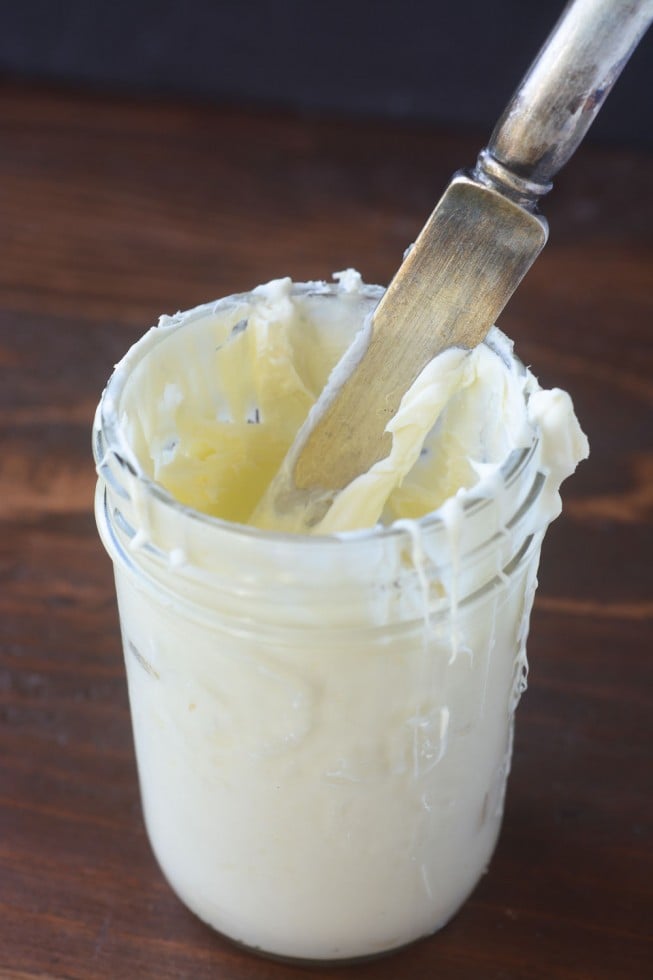
I can’t say enough good things about this project, the results far exceeded my expectations and it was absurdly easy. The only catch is that you can’t use ultra-pasteurized cream, which is cream that’s been processed for a longer shelf life. Many stores only sell ultra-pasteurized cream, so you have to search a bit for regular cream. I found mine at Whole Foods. Just read the labels… if it doesn’t say ultra-pasteurized on the label, you’re good to go.
can you make clotted cream with ultra-pasteurized cream?
Some readers in the comments below have had success with ultra-pasteurized cream. It is possible to make clotted cream from ultra-pasteurized cream, but it may be more difficult to achieve the desired texture and flavor. Ultra-pasteurization is a process that heats the cream to a higher temperature than regular pasteurization, which extends its shelf life but can also alter the proteins and enzymes in the cream. This can make it more difficult for the cream to form clots, which are necessary for making clotted cream.

What to eat with your homemade clotted cream
You will definitely want to make scones to go with your homemade clotted cream. I have lots of recipes for scones on the blog, but a simple one to start with is my Classic Cream Scones Recipe.
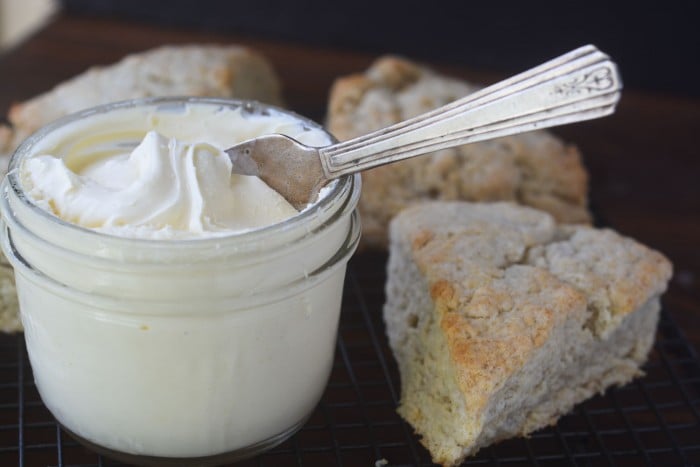
Tips for making clotted cream
- Make sure your cream is not ‘ultra pasteurized’, you will need to find regular pasteurized cream at a Whole Foods or other similar store. Ultra pasteurized cream has been treated in a way that prevents it from ‘clotting’.
- An oven thermometer is an essential kitchen tool, and really comes in handy for this project. If your oven is too cool or too hot your homemade clotted cream will not ‘clot’. Set your oven to 180F and then check the thermometer. You can adjust up or down as necessary.
- If your oven does not go down as low as 180F you can try one of my other methods for making clotted cream:

Homemade Clotted Cream
Video
Equipment
- a heavy casserole dish
Ingredients
- 2 pints heavy cream or whipping cream (double cream in the UK), avoid ultra-pasteurized cream for best results.
Instructions
- set your oven to 180F
- Pour the cream into the casserole dish. It should come up about 1-3 inches on the side.
- Set the dish, uncovered, in the oven and leave undisturbed for 12 hours. Be sure to leave the oven on the whole time. I do this overnight.
- Remove the dish from the oven and set to cool. Then cover and refrigerate. Note: the cream may seem thin at this point, but is going to thicken considerably overnight.
- The next morning scoop the thickened cream into a jar or jars, and cover and put back in the refrigerator. You can use the leftover cream for baking..
- Spread the clotted cream on freshly baked scones.
Nutrition


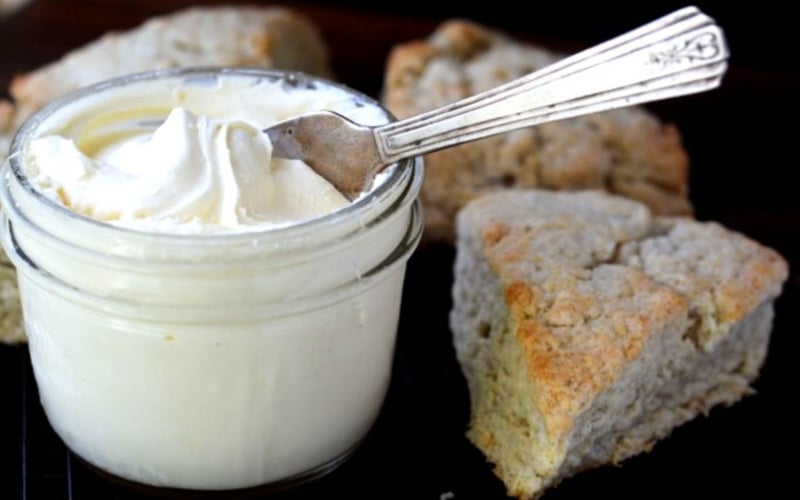




















Thank, thank, thank you for this recipe! We went to England almost 3 years ago and had tea in the town of Windsor, by the castle and had clotted cream for the first time. I thought it was the most decadent thing I’d ever had. My 14 year old son still wants to have tea with me after school at times. I found your recipe and decided to give it a whirl. Followed it to a T and it came out beautifully and soooooo delicious. I found another recipe that used the left over “cream” in some cream scones so nothing went to waste!! Ended up having tea and scones twice today, with a neighbor and with my son and hubby. Thanks again, you brought a lot of joy to someone who is missing England!
I’m thrilled this worked out so well for you Nichole, I know the feeling of missing a food, and I’m so happy I could help! We lived in England for a while for grad school and fell in love with so many great things — I have yet to master fish and chips 🙂
I might just try using organic heavy cream since everything is pasteurized these days. Ta for the recipe!
That’s what I use, Laurie, I get it at Whole Foods.
After reading through many of these comments, one thing to note is that just like butter (or whipped cream for that matter) clotted cream can be frozen. To use, thaw it in the fridge overnight. I’ve done it with fresh real clotted cream in the UK – actually kept frozen for several months and tasted great right up to the end. I have tried many, many times to make clotted cream from authentic recipes here in the US but generally, the cream in the US is not quite “fat” enough and of course the pasteurization is an issue. But I will give this recipe a go…thanks!
I devised my own “mock” clotted cream that, although it doesn’t have the divine smooth texture of the real thing, does have a rich similar taste. Take 8 oz. of mascarpone cheese and bring to room temperature. Then whip 1 pint Organic Valley (the highest fat cream I’ve found in a regular grocery store) and whip until very, very thick, just before butter stage. Then, fold (do not whip) the soft mascarpone into the whipped cream gently but as thoroughly as possible. Serve immediately or chill – it holds well and freezes well.
Very interesting Debbie — the freezing tip is wonderful to know. I’d be very curious to hear how this turns out for you, and the mock clotted cream is a fun idea too. Be sure to check back in after you try it 🙂
I am definitely going to try this recipe. It seems delicious, and if it’s anything like the clotted cream we had in the UK, then it is worth the try….
I got the cream from the health food store and instead of using the oven I use my Salton yogurt maker and it worked perfectly. So easy and so good!
Really? I’m going to have to try that now Joe, thanks!
How did the yogurt maker work for you? Joe P.
I haven’t tried it yet Joe because my yogurt maker has one large container that is tall and deep and I don’t think it would work…what size and shape is the container of your yogurt maker?
Sue,
It sounds like my yogurt maker has the same type of container, it holds one quart of the heavy cream. The entire quart thickens, a bit unevenly. I let it come to room temperature in its container before pouring it into the yogurt maker. Don’t know if that makes any difference or not.
The first I tried the clotted cream I used a yogurt strainer which didn’t yield more than a few drops of excess liquid so I stirred the whole batch with a spoon and it blended into a perfectly smooth product.
I tried ultra-pasteurized heavy cream in the yogurt maker, too, just to experiment. No clotting at 24 hours, about 1/3 clotted at 48 hours and perfect sour cream at 72 hours!!! So I’m sticking with the non-ultra pasteurized organic heavy cream from the health food store. My next experiment is to freeze it to see how that works, but so far, the refrigerated clotted cream has kept several weeks in the refrigerator, which I have set to 34 degrees F. (the thermometer on the door registers 40 degrees F.)
Joe P.
Sounds interesting…I did try it in my slow cooker on the ‘warm’ setting recently and only got about half the cream to clot, after about 24 hours. The yogurt maker will be my next experiment!
Looks delicious…I’m going to try this.
The Baltimore is nice however doesn’t compare to the Fairmont Empress in Victoria, B.C.
I’d love to visit that one some day 🙂
I will whole heartedly agree that the Fairmont Empress was one of the most beautiful and elegant places I’ve ever been to. The high tea was memorable!
OK now I HAVE to make a point to get there, thanks for stopping by Kam 🙂
Love the Fairmont Empress. Really enjoy their High Tea. However, since I live in the L.A. area, will have to give the Biltmore a try. In the meantime, this looks like the ticket to try at home.
I was so excited to try this but it did not work for me 🙁 I used a 8 x 8 inch pan and made sure the cream came up 1.5 inches on the side. Used 1 quart of pasteurized cream from Whole Foods (365 Heavy Cream). Cooked uncovered at 180 for 12 hours. When it came out, I noticed it still seemed liquidy and there was a thickish crust on top. I let it cool for about an hour and then put it in the fridge for 24 hours. When I went to scoop it out, it still had a thick crust. Under the crust there was still a good bit of liquid but also solid cream. However, the cream tasted more like cream cheese, not clotted cream.
Help! Any ideas as to what went wrong?! Thanks in advance!
First, I want to mention that I haven’t tried this yet, but I thought I might try to help since I don’t see any other responses yet. 🙂 I think that “crust” you describe is the clotted cream and is supposed to be scooped off (before refrigeration) and jarred. The liquid underneath that is leftover can be used or tossed, but is not part of the clotted cream. Hopefully I’ll be trying this tonight, so I’ll let you know tomorrow how it works out!
I make clotted cream a MUCH easier way by shaking the cream in a jar until just before the butter separates from the liquid. Pour heavy cream into a jar (I use a 1 quart Mason jar) – fill 2/3 of the jar only. Put some sort of agitator in the jar – I have a 1-inch wire wisk ball that I throw in there, but you could use a marble, a lego, etc – just make sure it’s clean 🙂 Then shake and shake. Check it often being sure not to let the butter separate out. You want to stop when it is super thick and sticking to the walls of the jar. At this point, you can use as is or gently strain it for several hours using a coffee filter in a sieve over a bowl. Voila!
Sherry, that’s not clotted cream, All that’s happened is that your cream’s butterfat has separated from the whey (the liquid at the bottom of the container) and congealed into those sweet butterfat clumps. Clotted cream needs to be cooked to form the clots, what you made I’m sure was nice but not the same.
My local Wholes Foods 365 brand IS ULTRA PASTEURIZED, so are you sure yours was NOT ultra-pasteurized ?
Hmmmm, they might have changed it since I bought it, not sure. I’ll check next time I’m there! Mine was definitely NOT ultra-pasteurized, but products are always changing.
I used a low temp pasteurized cream from Whole Foods. Wasn’t sure this was going to work but I gave it a shot. I’M SO GLAD I DID! It turned out absolutely perfect. I believe I could have ended up with more cream if it had stayed in there longer (I did 8 hours). A glass casserole dish is a must. Thank you so much for the tip!
Do you have any ideas for how to halve this recipe? I do have a smaller casserole pan that I could use but pasteurized organic heavy cream is so expensive that I’m a bit leery to try it out on my own.
I know how you feel, Nayda. All I can tell you is that I didn’t have luck when I tried to make it with half the cream. I figured maybe you need the extra bulk of cream so that it doesn’t overcook. Not sure, though, sorry!
This sounds to die for! I had no idea clotted cream was so easy to make. I’ll definitely have to give this recipe a try. I could so go for a scone and some clotted cream right now!
So I just pulled this out of the oven and from the other comments… Sounds like I’m on the right track. After the only British tea place we had here closed down, I’ve been dying to get my hands on some clotted cream. Will be making scones on my next day off so I’m excited for this and hope it turns out! As a lover of all things British, thank you sooooo much for this recipe.